Savory, umami, nutty, and with just enough heat to warm the palate, my Szechuan style nasu dengaku is the perfect side dish to complement a traditional Japanese or Chinese meal, a vegetarian dinner, or to enjoy with a simple bowl of rice. It’s not only delicious but also beautiful to look at!
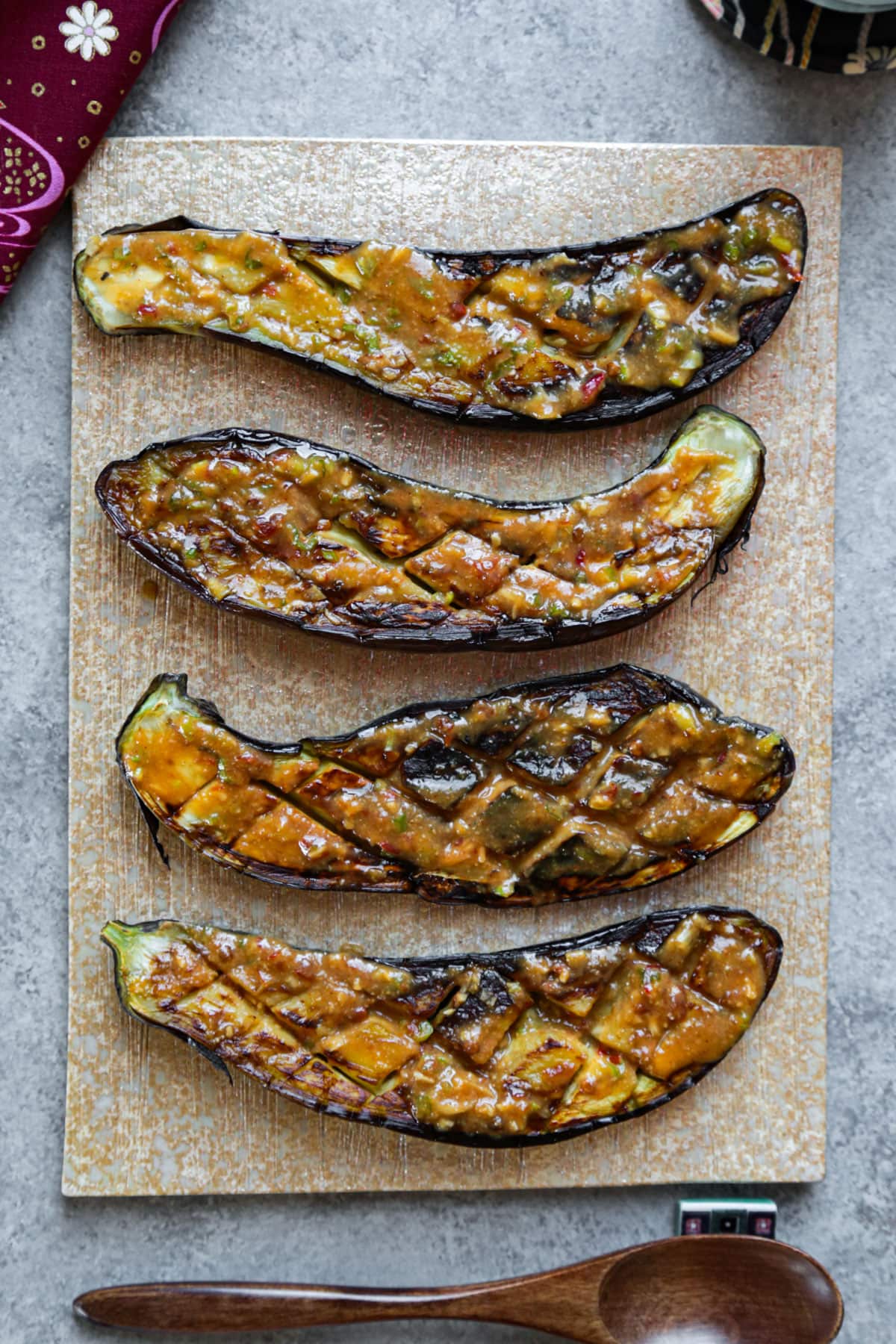
If you like my traditional nasu dengaku or tofu dengaku recipe, wait until you try this one! I came up with this recipe after seeing all the different ways that broiled and roasted eggplants are served in Japan. I have been cooking with Japanese and Chinese eggplants for years now and love how quickly and easily they become tender. The lack of seeds also yields the silkiest flesh that almost melts in my mouth. While I usually like to pan fry my eggplants whole until the skin get slightly charred, and dress them with a little tsuyu and some chopped green onions, this Szechuan style nasu dengaku is quickly becoming a new favorite of mine.
The steps are easy to follow and the flavors are well balanced. The mixture of nutty, savory, umami, slightly pungent, peppery, and spicy from the sauce, marries beautifully with the mildly sweet flavor of eggplant. My recipe only requires 7 ingredients and takes about 20 minutes to make.
Table of contents
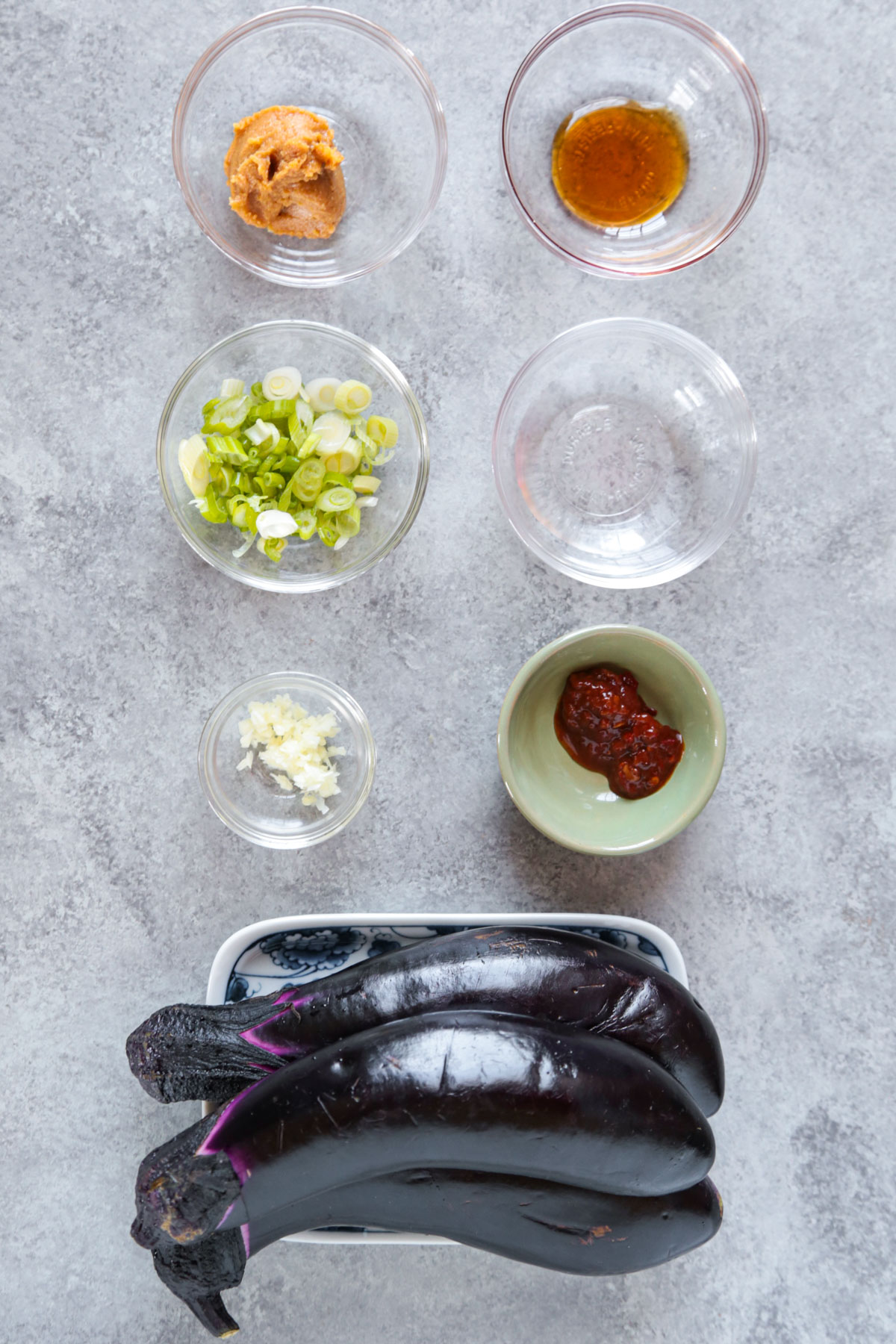
Ingredients
Scroll down to the recipe card for the full recipe.
- Eggplant: Japanese or Chinese eggplants are the best ones to use for this recipe because they are thinner and the skin is edible. Japanese eggplants are a little shorter than Chinese eggplants but have the same consistency.
- Miso paste: I am using white miso paste because it’s milder than other types and won’t overpower the overall taste of the dish. But feel free to use awase miso paste, which is a mix of both white and red miso paste, if you enjoy a stronger and saltier flavor.
- Water: A little water is needed to thin the sauce so it spreads more easily onto the sliced eggplants.
- Garlic: 1 grated garlic clove adds a fragrant and slightly floral element to the Szechuan style sauce.
- Doubanjiang: Doubanjiang is a fermented chili bean paste used in Chinese cooking to add heat and a savory element to Sichuan dishes.
- Honey: A little honey is used for sweetness and to balance the saltiness of the other ingredients.
- Green onion: Chopped green onions are refreshing and add a little crunch to this otherwise soft and tender dish.
Variations
- Make it spicier: Add an extra teaspoon of doubanjiang or 1/2 teaspoon of grated ginger.
- Make it vegan: Swap honey for pure maple syrup or sugar.

How To Make It
- Slice the eggplants in half and cut a criss-cross pattern in the flesh.
- Cook the eggplants in a skillet over medium high heat on both sides, until they are tender.
- Make the Szechuan style dengaku sauce and brush it over the eggplants.
- Transfer to a serving plate and serve as a side or with a bowl of rice.
Expert Tips
- Cooking time may vary: Depending on the thickness and size of the eggplants, and also the type of stove top you have (gas, electric), cooking time may vary. The recipe says to cook the eggplants on each side for 3 to 4 minutes, but it may take longer or shorter. The only thing to know is that the eggplants must be fully cooked and tender before they are transferred to a plate.
- Use a type of honey that’s not too floral or medicinal: Some types of honey, such as wildflower and manuka, can have a strong floral or medicinal taste that can be overwhelming when mixed with savory ingredients. Stick to something on the plainer side like raw clover honey.
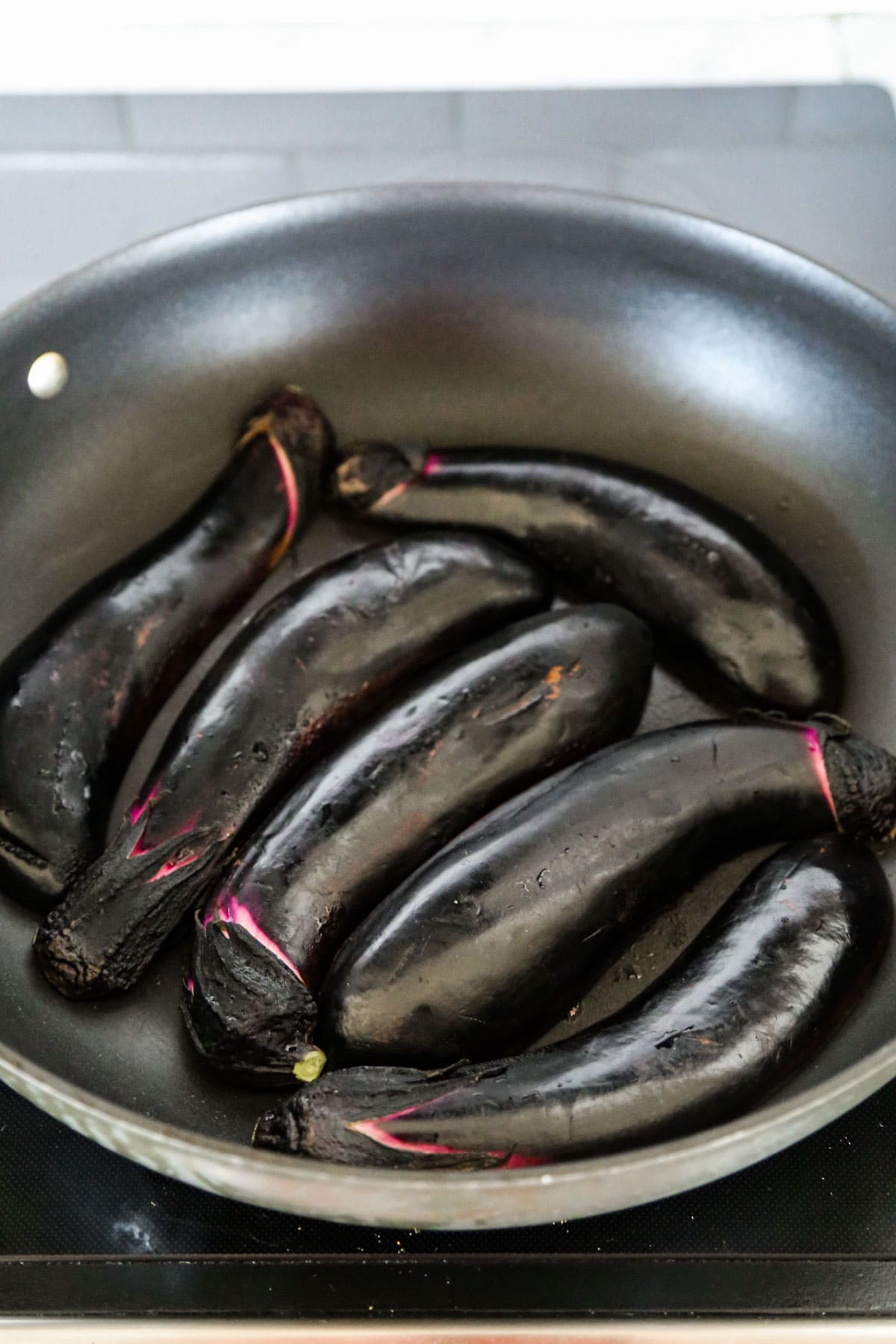
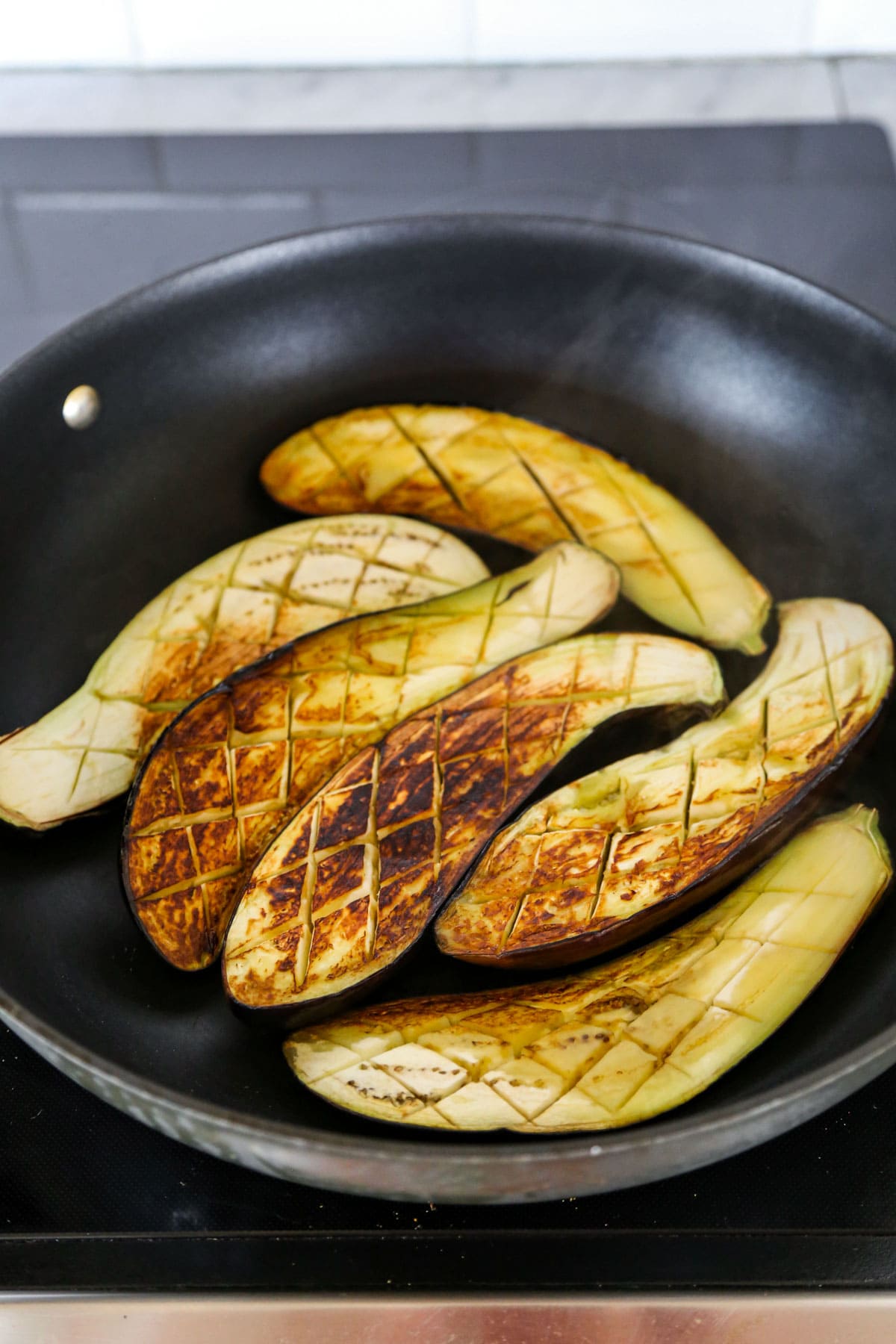
Storage and Reheating
Fridge: Transfer the nasu dengaku in an airtight storage container and refrigerate for up to 2 day.
* I don’t recommend freezing this dish since the texture of the eggplant will deteriorate over time.
Reheating: Microwave on low for 1 to 2 minutes. It’s better to do it on low to preserve the aroma and the nutrients of the miso paste.
What To Serve With Szechuan Style Nasu Dengaku
The savory, nutty, and deeply umami taste of this eggplant dish means it pairs well with other dishes that have a similar flavor profile. Needless to say it goes well with Japanese, Korean, or Chinese cuisine, with dishes such as fried noodles with soy sauce, honey sriracha tofu, omurice, miso ramen, Korean sticky chicken, or japchae. It also pairs well with smaller sides and can be served as part of an izakaya style dinner. Some of my favorites are edamame with soy and sesame sauce, maki rolls, Korean chive pancakes, blistered shishito peppers, and mushroom and cabbage dumplings.
Other eggplant recipes you might like: Chinese eggplant with garlic sauce, Chinese style eggplant with sesame sauce, Japanese eggplant tartare, steamed Korean eggplant (gaji namul), char siu style roasted eggplant, stir fried eggplant with seitan, sauteed Japanese eggplant, mabo nasu.
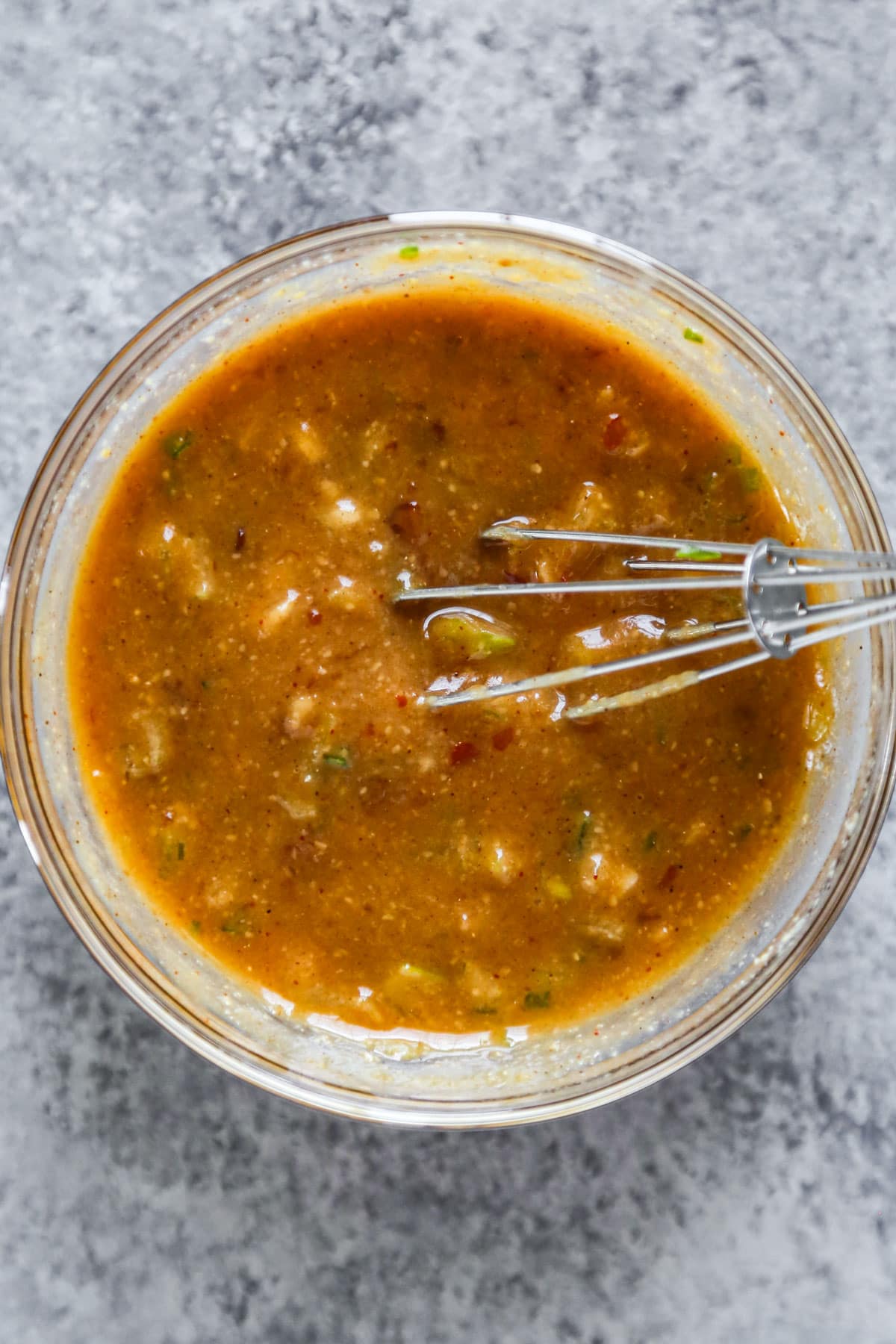
Frequently Asked Questions
It depends on the doubanjiang used. One Japanese brand carries a gluten-free doubanjiang and is also the one I used for this recipe. Some miso pastes may also contain gluten if they have barley, wheat, or rye. Make sure to look for one that’s 100% gluten-free.
No, I really don’t recommend a regular bulbous eggplant for this recipe. Mainly because the skin can be tough even once it’s cooked, and the flesh contains a lot of unpleasant seeds. If you do still want to give it a shot, slice the eggplant into quarters or eights, lengthwise.
Try a chili paste like sambal oelek to mimic the flavor of doubanjiang. It will not be the same but you will get plenty of heat from it. Gochujang can also be used but will add a smoky element to the dish.
This step isn’t needed for this recipe since the sauce is strong enough to mask any bitterness. Also, I find that Japanese and Chinese eggplants are generally a lot less bitter than other types of eggplants.
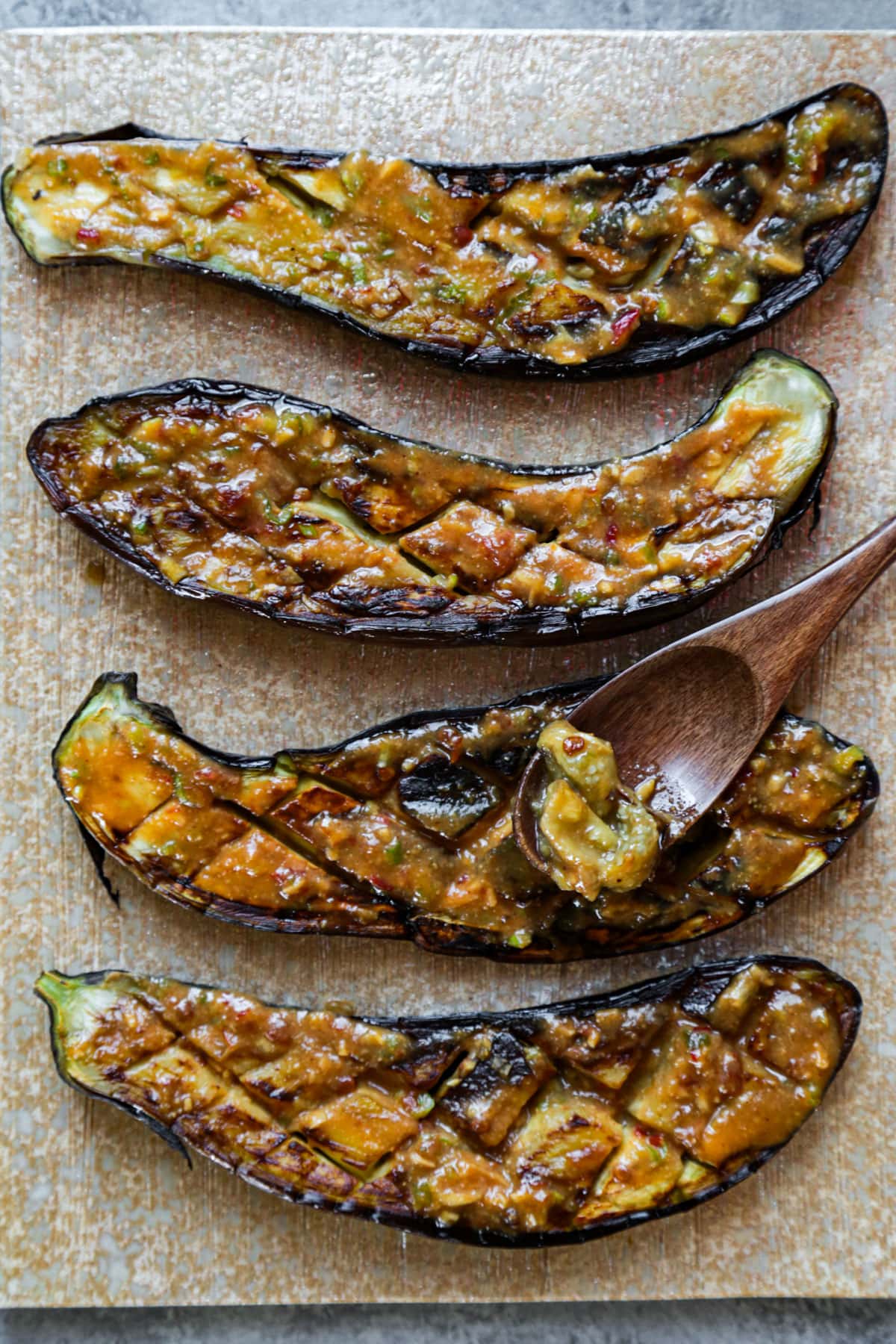
TABLEWARE
Like some of the tableware in this post? They are available at Musubi Kiln.
Musubi Kiln is an online store specializing in high quality handmade Japanese tableware and dinnerware. Each product is made by Japanese craftsmen using traditional techniques that have been passed down from generation to generation.
Receive 10% off your purchase when using the code CAROLINE at checkout.

Did you like this recipe? Are there changes you made that you would like to share? Share your tips and recommendations in the comments section below!
Print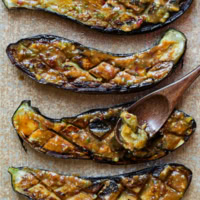
Szechuan Style Nasu Dengaku
- Prep Time: 10 minutes
- Cook Time: 10 minutes
- Total Time: 20 minutes
- Yield: 4 servings 1x
- Category: Main
- Method: Skillet
- Cuisine: Japanese
- Diet: Vegetarian
Description
This Szechuan style nasu dengaku is savory, umami and nutty, and has just enough heat to warm the palate.
Ingredients
- 3 medium size Japanese eggplants or Chinese eggplants
- 2 tablespoons neutral oil such as vegetable oil or grapeseed oil
- 2 tablespoons miso paste
- 2 tablespoons water
- 1 garlic clove, grated
- 1 1/2 teaspoon doubanjiang
- 1 teaspoon honey
- 1 green onion, minced
Instructions
- Cut the eggplants: Slice the eggplants in half, lengthwise.
- Heat the skillet: In a large nonstick skillet over medium high heat, add the oil and swirl it around to coat the surface.
- Cook the eggplants: Add the eggplant with the cut side facing down. Cook for 3 to 4 minutes, until the flesh is a light brown color and slightly tender. Flip the eggplant slices and cook for another 3 to 4 minutes. The eggplants are ready when they are soft and tender. Turn the heat off and transfer the eggplants to a serving plate.
- Make the Szechuan dengaku sauce: Add the miso paste, water, garlic, doubanjiang, honey, and green onion to a small bowl and whisk until combined.
- Serve: Pour the sauce over the sliced eggplants and serve.
Notes
Store the leftovers in an airtight storage container and refrigerate for up to 2 day.
Nutrition
- Serving Size: 1 serving
- Calories: 154
- Sugar: 11.3g
- Sodium: 19.9mg
- Fat: 7.9g
- Saturated Fat: 5.7g
- Unsaturated Fat: 0.4g
- Trans Fat: 0g
- Carbohydrates: 20.7g
- Fiber: 9.1g
- Protein: 3.9g
- Cholesterol: 0mg














